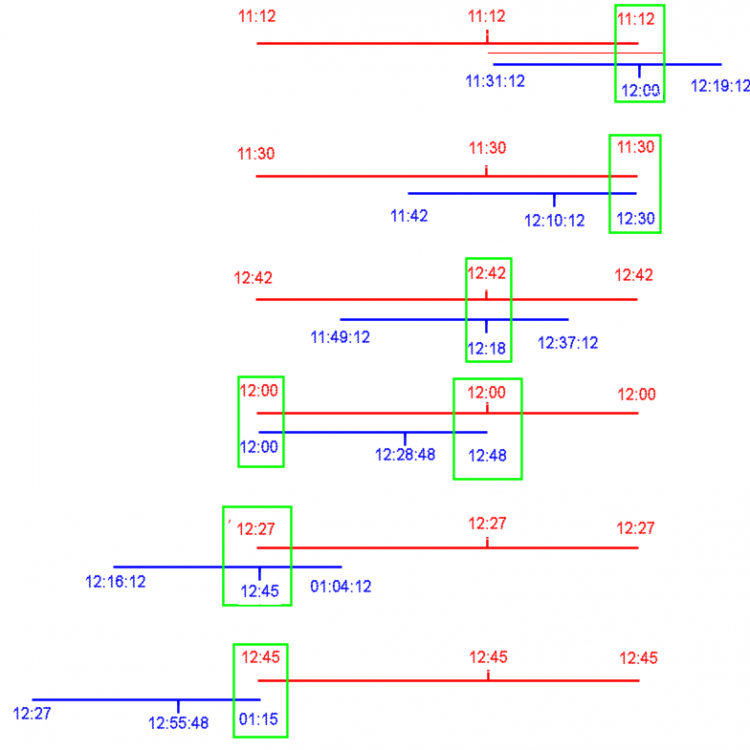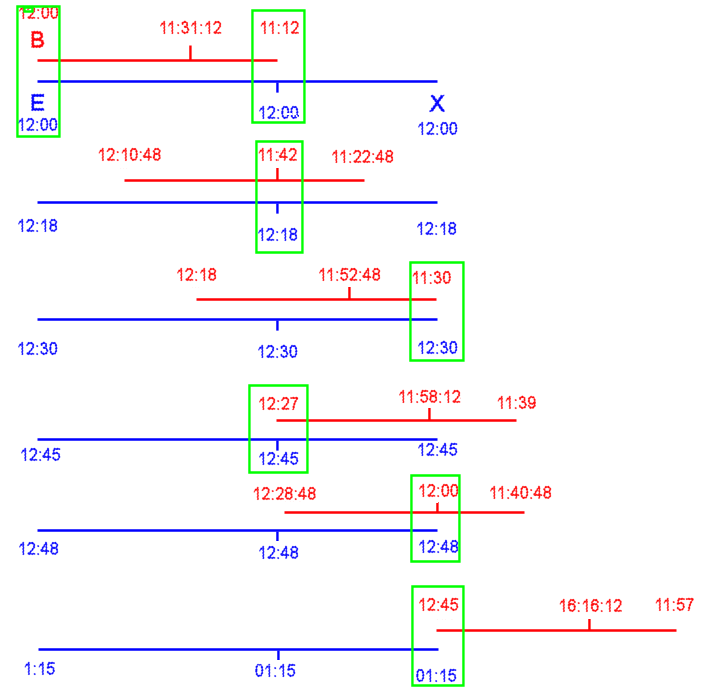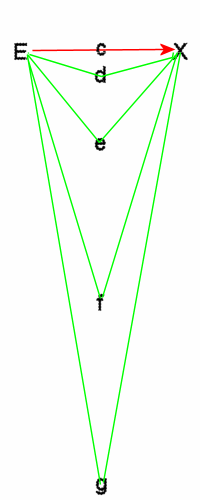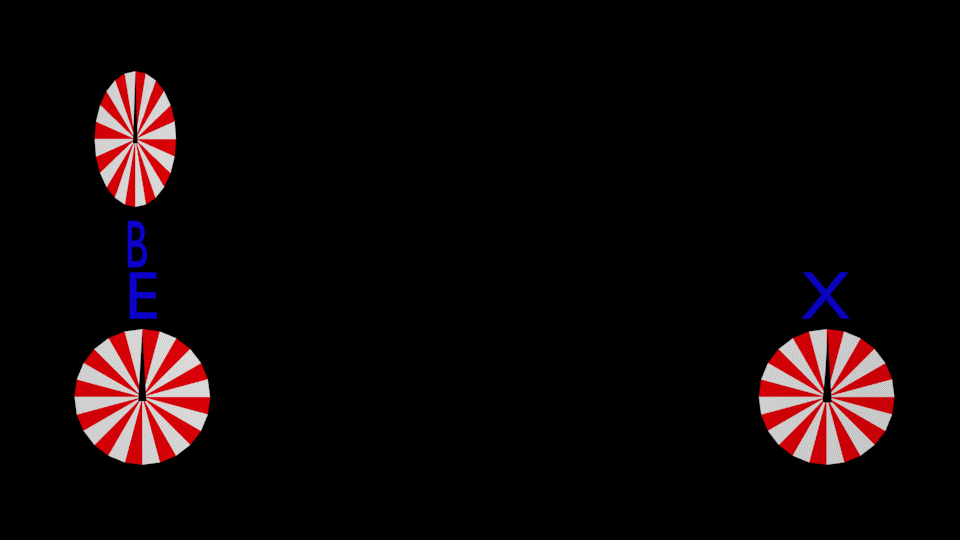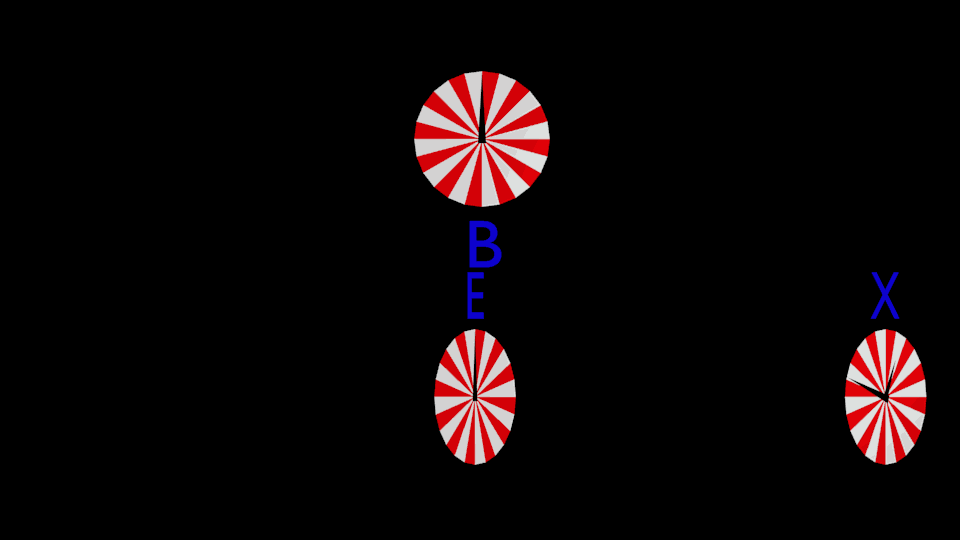-
Posts
2197 -
Joined
-
Last visited
-
Days Won
44
Content Type
Profiles
Forums
Events
Everything posted by Janus
-
Each set of images shows a series of chosen moments for each frame. Those moments are chosen as they represent when a pair of clocks pass each other. The numbers tell us what clocks at those positions read at that moment according to the chosen frame. So each successive diagram in the image represents a single moment in time. Thus in the first image of the first set, All the clocks on the E-X rod read the same time(12:00) at that moment, while the clocks along the B rod do not ( reading 12:00, 11:31:12, and 11:12 as you go from left to right) at that same moment.
-
Spacecraft during re-entry only get up to ~ mach 25, and even at that speed, the air is heated to a plasma state. Craft like Apollo and Soyuz use ablative shields that burn off to deal with it. And this is in the upper part of the atmosphere, where the air density is very low.
-
Your error is that you again are not taking relativity of simultaneity into account. To illustrate, we can put clocks at the end of rod attached to B and at the point's along the rods. Thus from The E-X rest frame you get this: The green boxes indicate two clocks passing each other and their respective readings as they do. In the rest frame of B, you get this: Comparing the the times shown in the green boxes as clocks pass each other agree with those in the first image. In each image, there is a an instance when two pairs of clocks pass at the same time, but they are different pairs of clocks in each image. This just illustrates that, with the Relativity of simultaneity, events that are simultaneous for one frame of reference are often not simultaneous for another.
-

how much of the outer universe can we see from where we are?
Janus replied to boo's topic in Astronomy and Cosmology
About 10% of the universe is "hidden" from our view by the bulk of our own galaxy (20% if you only consider the visible part of the spectrum). This won't change much due the rotation of the galaxy as this is mostly due to having to view through the disk of the galaxy. -
My mistake, I thought you were here for a rational discussion.
-
While not intentionally, a fix to a design problem provided one. One of NASA's missions to a moon of an outer planet required communication between an orbiter and lander. This used a protocol which involved a narrow frequency tolerance. The problem arose because the tolerance was made too tight and the transmission frequency of the lander was off just a bit. The "fix" they came up with was to alter the orbiter's orbit so that at specific times, its velocity with respect to the Lander caused a Doppler shift which compensated for the drift. The lander would dump its gathered data during these "window"s. Now if there had been an "ether wind", the Moon's orbit around its planet, and the Planet's velocity would have had an effect on that Doppler shift. In other words, Not only would they had to account for the relative velocity between lander and orbiter, but these other motions as well. And since these motions changed with time relative to the orbiter's orbit, NASA would have had to either keep adjusting the Orbiter's orbit or changing the "transmission window" to keep up. They didn't. The only thing they needed to concern themselves with was the relative velocity between orbiter and lander, which would not have worked if there had been an ether wind. T
-
The reason the tidal interaction transfers angular momentum from Earth to Moon is that the drag between the Earth and tides causes the tidal bulges to be pulled "ahead" of the Moon. If you removed this drag completely, the bulges would remain lined up with the Moon, and there would be no momentum transfer. Increasing the drag would allow the spinning Earth to pull the bulges even more out of line, increasing the tendency transfer energy to the Moon. As far as energy goes: Most of the energy lost by the Earth through its slowing rotation is not transferred to the Moon, but is lost as heat.( the Moon gains less orbital energy than the Earth loses rotational energy). So it doesn't really work to think of energy "used" by the turbines as being taken away from energy given to the Moon. Look at it this way. If we just increased the drag without generating electricity, we would increase the amount of energy the Earth loses in rotational energy both by transferring some to the Moon, and by waste heat. By extracting some of that energy by converting it to electricity, you are making use of a part of that energy that would have been lost as heat.
-
So, I read that Trump planned his town hall after hearing about Biden's, and his intent was to "blow Biden out of the water" in the the viewership ratings ( you know how important Trump thinks TV ratings are). The ratings came in: Biden's were better. Trump's blood must be boiling, and I wouldn't want to be the flunky he' s going to lay the blame on.
-
Tidal interaction between the Earth and Moon transfers angular momentum from the Earth to the Moon, slowing the Earth's rotation and raising the Moon's orbit. Turbines intended to extract energy from the tides would increase the ocean tide- Earth drag. This would magnify this transfer. In effect, the energy comes at the cost of the Earth's rotation. But as Swanson alluded to, a comparison of the comparative magnitudes would be informative as to the overall effect on the rotation.
-

Dark matter (split from Dark matter does not exist ?! What do you think ?)
Janus replied to MSC's topic in Speculations
A couple of points: Galactic rotation curves show that orbital velocity remains nearly flat as you move outward. For the galaxy to appear to rotate as one piece, they would need to increase proportionally with R. At the same velocity, a star closer in still takes less time to complete an orbit than one further out. This image plots the various curves. note that the vertical axis is in km/sec. So, why don't we see the spiral arms "wind up"? It is because the spiral arm formation is due to a different mechanism than the orbital motion of the stars. They are produced by density waves moving through the Galaxy. Since these waves do not travel at the same rate as the rotation, stars drift in and out of them. A bright spiral arm is where a wave has the highest density. As a result, you get a higher rate of stars being born there. This includes massive, bright stars. But these stars have short lives, and burn out fairly quickly. By the time the stars in a spiral arm drift out, these brighter stars have spent themselves and you are left with the dimmer longer life stars. The spiral arms look bright not because they contain that much more stellar material, but because they contain a larger percentage of bright stars. This bright star vs. dim star paradigm happens in our own night sky. If you go out on a clear night away from city lights, you will see a sky full of stars. But you are really only seeing, for the most part, brighter than average stars. Our own Sun would be only visible by naked eye over a distance of a few 10's of light years. The vast majority of stars we see are much further than that, they are just much brighter than our Sun. Within 17 light years of the Earth, there are ~50 stars, only 10 of which are visible by the naked eye. Some of it might be objects like black holes, etc ( MACHO's, or MAssive Compact Halo objects) Though there are limits as to how much these can contribute due to how they would have effected the early formation of the universe. Some of it could be made of particles which don't interact via electromagnetism (WIMPs, or Weakly Interacting Massive particles) There is nothing that rules out such particles (In fact, the neutrino has these characteristics.) And don't let the fact that it makes up so much the universe mislead you. It is also spread out over much larger volumes than the more compact structures like galaxies. It is estimated that the density of dark matter within our solar system is so low that the total of its mass would only equal that of a small asteroid. -
The distance between c and E and The distance between c and X are the same. So are you claiming that an observer at c will say an object going from E to X ( along the red arrow) traveled zero distance? Of course not. The same holds for an observer at d, or e, f and g. They all would say that an object moving from E to B traveled the same distance in the same time. It doesn't matter how far you put your observer away, the traveled distance doesn't converge to 0, but remains the same.
-
No, the geometry does not evidently show the relative velocity as be almost null. As the observer gets further away, the angular velocity he would measure would decrease, But since the actual relative velocity is w x d*, Where w is the observed angular velocity and d is the distance to b, the increase in d cancels out the decrease in w and gives a constant answer for the relative velocity no matter how far the distance d is. Also, the distance between E and X doesn't change with an increase of d, and the fact that the E- observer distance and the X-observer distance is the same, just makes its easier for the observer to determine that B traveled at 0.8c . For example, lets assume that the observer is 1000 ly away from both. B leaves E, and the light of this event heads off towards our observer, it takes 1000 yrs to reach him. It takes 1 1/4 hours for B to reach X, so 1 1/4 hr after the light of B leaving E is emitted, the light of B arriving at X is emitted. It also takes 1000 yrs to reach the observer. This means that the light telling the observer that B arrived at X arrives 1 1/4 hrs after the light telling the observer that B arrived at X. Since the observer knows that he is an equal distance from both, he know that the light from these events took equal times to reach him, so he knows that the 1 1/4 difference between his seeing these event is exactly the same as the time it actually took B to go from E to X. The distance between E and X is 1 light hour, so he knows be traveled at 0.8 relative to them, and since he is at rest with respect to them, 0.8c relative to himself. This is all pretty straight forward, and in no way supports your conclusion. * technically, this equation assumes that B is traveling along an arc of a circle with our observer at the center. B is actually traveling a straight line. This would have the effect of causing the measured angular velocity to change as B went from E to X. Starting at a one value, increasing to a maximum at the midpoint, then decreasing again. This variance in angular speed would be largest with small values of D and decrease ( but never totally vanish) at larger values of D. If we assume D is very large, we can safely ignore this without too much loss of accuracy.) While complicates things a bit, it does not change the fact that our observer will always get a value of 0.8c for the velocity of B
-
Again, You are not getting the concept of inertial frames of reference. Planet X and Earth ( and their associated clocks) are at rest with respect to a single inertial reference frame. According to that reference frame the Earth clock and Planet X clock are in sync. B is also "in" that inertial frame, but not at rest with respect to it. Likewise, there is a reference frame where B is at rest, while Earth and planet X are in motion ( in fact, there are an infinite number of inertial frame two choose from, It is just that these two are the most convenient to work with.) So in the second animation, we are making our determination from the later of these two frames. In that frame, the distance between Earth and Planet X is 0.6 light hr. And is as measured from that frame that planet X's clock is 48 min ahead of Earth's clock. In the "rest frame" of Planet X and the Earth, the distance is 1 light hr, and the clocks are in sync ( planet X's clock reads 12:00 when B passes Earth) What you are trying to do is called "mixing frames" ( trying to use measurements from two different frames at the same time.). This only leads to confusion.
-
No, not really. In most discussions dealing with Relativity, we factor out the light signal delay effects. Thus if the Earth "sees" 11:00 on Planet X's clock when the Earth clock read 12:00, The Earth knows that the light carrying that image left planet X 1 hr ago when the Earth clock read 11:00 and thus both clocks read 11:00 at that moment. And assuming that Planet X remained at rest with respect to the Earth, that in the time it took the light to reach the Earth, the Planet x clock ticked off 1 hr and thus reads 12:00 when that light arrives at Earth and the Earth clock reads 12:00. Thus the Earth would conclude that the the two clocks are in sync. Planet X would conclude the same from its observations of Earth's clock from a distance of 1 light hr. Relativity is what is "left over" after you account for light signal delay.
-
I don't think you understand what "frame of reference" means in Relativity. It is not the same as a "point" of reference. A frame of reference includes all points regardless of their relative position that are at rest with respect to each other. So as long as Earth and X are motionless with respect to each other, they share the same frame of reference, and there is not an "Earth frame of reference" and a "Planet X frame of reference", but a single reference frame which Earth and Planet X are at rest with respect to. And in that reference frame, the Earth and Planet X clocks are synchronized. The fact that different observers placed at different positions in that reference frame would visually see different times on those clocks does not change the fact that all these observers would agree that these clocks are "in fact" synchronized with each other. Differences in position has no effect on the determination of simultaneity, only differences in velocity.
-
Relativity of simultaneity. Since the clocks are synchronized in the Rest frame of Earth and X, they can't be in the rest frame of B. Below we have three clocks all a t rest in the same frame. The clocks are synchronized in this frame. The central clock emits a pulse of light which expands outward at c, and when it reaches the other clocks, they emit each emit a light pulse. These pulses meet at the center clock. Note that int this frame, all three clocks read the same when the pulses are emitted and when they meet at the central clock. Now we consider the exact same scenario, except now we consider events according to a frame of reference that is moving relative to the clocks. Unlike the first animation, the clocks do not remain at the center of the light pulses they emit. This is because light must move at c relative to this frame as measured from this frame. Thus each pulse expands at c from a point that remains at rest with respect to this frame of reference, and the clocks move away from that emission point after emitting the pulse. In this frame, the clocks run slower, they and the distance between them is length contracted. What does remain consistent is what time each clock reads when a light pulse reaches it or it emits a pulse. Now, when the center clock emits its pulse, the clock at moving relative to the center emission point from which the pulse is expanding at c. as a result, the leftmost clock runs into the first pulse and emits its pulse before the rightmost clock does. Each of these pulses expand out at c from their emission points and meet up at the center of the central clock. In order for the pulses to arrive at each clock when that clock is reading the same time as it was in the first animation, the clocks cannot be in sync in this frame. This the reality of Relativity. You can complain all you want about how "this doesn't make sense" or that you can't accept this as being true, but that will not change the reality of it.
-
You have to apply them properly, and you need to allow for the relativity of simultaneity while also taking into account what frame you are measuring from. This is how events unfold according to Earth and Planet x. B and it clock are length contracted and B's clock is time dilated. The length contraction doesn't really play a role in the out come here. B leaves the Earth and take's 1 hr 15 min as measured by Earth's and planet X's clock to cross 1 Lh at 0.8c. B's clock is time dilated and only ticks of 45 min during the trip. Note that the animation pausing at the end is not meant to mean B stopping at X, only that the animation "freezes" at moment so that we can compare clock readings for that moment. If we now consider things from B's inertial frame of reference, you get this. B is at rest while the Earth and planet X move to the left at 0.8c. the Earth, planet X, their clocks, and the distance between them is length contracted. B is not. It take 45 min by B's clock for planet X to travel from being 0.6 lh away to B at 0.8c Earth and planet X's clocks are time dilated and only accumulate 27 min during this time. However, due to Relativity of Simultaneity, the Planet X clock already reads 48 min later than Earth's clock when B and the Earth are next to each other. Thus the 27 minutes it advances brings it to 1 hr 15 min, as it passes B. The times on Earth's clock and B's clock when they are next to each other agree with the first animation, and the Times shown on B's clock and Planet X's clock when they are next to each other also agree with the first animation.
-
It's the answer I get.
-
The formula N =N0 e-ct Gives you the number of remaining atoms(N) starting from an Original number of atoms(N0) when you know the time of decay(t) and the decay constant (c) You are given t and N/N0. From this, you should be able to solve for c Further, cT = ln(2), where T is the half-life. This should be enough to solve the problem (though as you suspected, 173,000 yrs is a "rounded out" answer.)
-
The speed of light in a vacuum is invariant as it is c. This not only means that the speed you measure for it doesn't depend of the motion of the source, or your motion. Light in a medium doesn't travel at c, but as Swansont said, is c/n. Any speed less than c is not invariant. In this case, the measured speed will depend on whether it is the observer or source that it moving relative to the medium. But also as already mentioned, you need to use Relativistic velocity addition to get the correct answer. Relativity doesn't "just go away" because light is now longer moving at c. It is also important to understand that is the speed "c" that is important and not the speed of light itself. When someone says that you cannot exceed the "speed of light", they mean "c", which is the speed light travels in a vacuum. It is possible to exceed the speed of light for a given medium, even in that medium. For instance, there is a type of nuclear reactor which is surrounded by water. It produces subatomic particles which travel through the water at speeds greater than the speed of light through the water. This produces a type of electromagnetic "shock wave", which is seen as a faint blue glow known as Cerenkov radiation.
-
ZENO: The chicken couldn't have crossed the road. It would have first had to cross halfway, then halfway the remaining distance...
-

Split from Time dilation dependence on direction
Janus replied to Charles 3781's topic in Relativity
This reminds me of a quote by Robert Heinlein: “Expertise in one field does not carry over into other fields. But experts often think so. The narrower their field of knowledge the more likely they are to think so.” van Flandern got his degree in Astronomy, specializing in celestial mechanics. Yet he thought this expertise carried over to understanding the nature of gravity itself. -
The perspective effect is due to the fact that objects of the same size subtend a smaller angle of your visual field as the distance to them increases. If the observer is moving relative to the object, a second visual effect also has to be taken into account: aberration. Aberration affects the angle at which you will see the light coming from. In the case where you are looking at an object coming towards you, the angle tightens inward making the object "look" smaller. So let's go back to my last example: A and B both see light coming from planet X as they pass each other. They see the same light. The difference is that due to aberration, A sees the light come from a smaller angle, and visually "sees" a smaller image. Now this is not inconsistent with what I said about what he concludes, which is that the light he is now seeing left planet X when it was 3 light hrs from him, thus he would expect to "see" a smaller image. The point is that there is nothing about what A "sees" that runs contrary to, or is inconsistent with, what Relativity says is happening. Relativity usually ignores these secondary "visual" effects, not because it can't deal or account for them, but because at best, They don't tell us anything important, and at worst, they add unnecessary "clutter" to the scenario.
-

Weather in your hometown (split from Climate change and global warming)
Janus replied to Airbrush's topic in Climate Science
We had bad air quality for ~ a week, staying in the "Very unhealthy" to "Hazardous" ranges. We tried to seal things up as best we could, but the smell of smoke still found its way in. We were stuck in a thermal inversion that was holding the smoke near the ground. We finally broke out of it Friday, when a system finally blew in. Had good air quality for a few days, then it jumped back up to over 130 today again, before dropping back to under 100 this evening.


